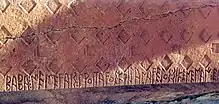Yazılıkaya, Eskişehir
Yazılıkaya (lit. 'inscribed rock'), Phrygian Yazılıkaya, or Midas Kenti (Midas city) is a village in Eskişehir Province, Turkey known for its Phrygian archaeological remains and inscription mentioning Midas.

The ancient remains are sometimes called the Midas Monument or Midas City and were formerly identified as the tomb of Midas.[1][2]
Yazılıkaya is about 27 km south of Seyitgazi, 66 km south of Eskişehir, and 51 km north of Afyonkarahisar.
The Midas Monument

The most prominent part of the Midas Monument is a high rock-cut facade with an incised decoration apparently showing a pedimented temple front with acroteria, faced with terra cotta and with a niche at the bottom center. The niche's walls bear graffiti reading MATAR (Mother, i.e. the goddess Cybele) and it probably held a statue of Cybele.[3]
The monument carries a dedication in Old Phrygian by Ates son of Arkias to Midas (ΜΙΔΑΙ ϜΑΝΑΚΤΕΙ), and probably dates from the 7th or 6th century BCE.[3][8] The inscription mentions Midas with his titles: MIDAI LAVAGTAEI VANAKTEI, probably meaning "leader of the people" and "ruler".[7] The inscription is:
ATES... MIDAI LAVAGTAEI VANAKTEI EDAES
Ates.... has dedicated [this monument) to Midas, lavagtas and vanax.[6]
Excavation history
The site was excavated by the French Archaeological Institute immediately before and after the Second World War, and also in the 1990s by the Eskişehir Museum.[9][10]
Notes
- William Mitchell Ramsay, 1890, cited in Munn, p. 70
- Roller, Lynn E. (1999). In Search of God the Mother: The Cult of Anatolian Cybele. University of California Press. p. 84-110. ISBN 9780520919686.
- Munn, p. 77
- Баюн Л. С., Орёл В. Э. Язык фригийских надписей как исторический источник. In Вестник древней истории. 1988, № 1. pp. 175-177.
- Orel, Vladimir Ė (1997). The language of Phrygians. Caravan Books. p. 14. ISBN 9780882060897.
- Woodard, Roger D. (2008). The Ancient Languages of Asia Minor. Cambridge University Press. p. 78. ISBN 9781139469333.
- Roller, Lynn E. (1999). In Search of God the Mother: The Cult of Anatolian Cybele. University of California Press. p. 69. ISBN 9780520210240.
- Bienkowski
- Midas City, "Digital Gordion", Gordion Archaeological Project, University of Pennsylvania. Includes good images.
- A. Gabriel, Phrygie, Exploration archéologique 2,4 1952; G.H.E. Haspels, Phrygie, Exploration archeologique III, La Cite de Midas, Ceramique et trouvailles
Bibliography
- Piotr Bienkowski, Alan Millard, Dictionary of the Ancient Near East, p. 198.
- Albert Gabriel, "Au sujet du «Monument de Midas»", Comptes rendus de l'académie des inscriptions 94:2:202-208 (1950)
- C.H.E. Haspels, The Highlands of Phrygia: Sites and Monuments, 1971, ISBN 0691038635.
- Mark Henderson Munn, The Mother of the Gods, Athens, And the Tyranny of Asia
- William Mitchell Ramsay, "The Rock Necropoleis of Phrygia", Journal of Hellenic Studies 3, 1882.
External links
- Midas City at Phrygian Monuments.
- Yazilikaya - Midas Sehri at the TAY Project (Archaeological Settlements of Turkey)

